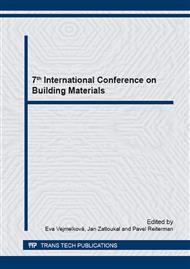p.101
p.105
p.111
p.117
p.121
p.127
p.133
p.139
p.145
Behavior of Cement Composites Loaded by High Temperature
Abstract:
In this paper, there are summarized the results of an experimental program focused on basic, mechanical and thermal properties of cement composites according to the high – temperature loading. Four different materials were studied, which differed in used kind of cement and amount of fibers. As a matrix for studied composites the aluminous cement was chosen because of its resistance in high temperature. For a comparison the Portland cement was also tested. The second main ingredient used to provide better resistance in high temperatures - the basalt aggregate, was mixed in every specimen. The basalt fibers were chosen for two of the measured samples, remaining two ones were tested without fibers. The obtained data in this presented analyses show that the application of the aluminous cement leads to increase (depending on temperature) of porosity, which is the cause of decreasing of the coefficient of thermal conductivity. It can seems, that these cement composites will have low mechanical strength in high temperatures, but because of better sintering, the aluminous cement keeps its strength in high temperatures better than Portland cement.
Info:
Periodical:
Pages:
121-125
Citation:
Online since:
July 2015
Authors:
Price:
Сopyright:
© 2015 Trans Tech Publications Ltd. All Rights Reserved
Share:
Citation:


